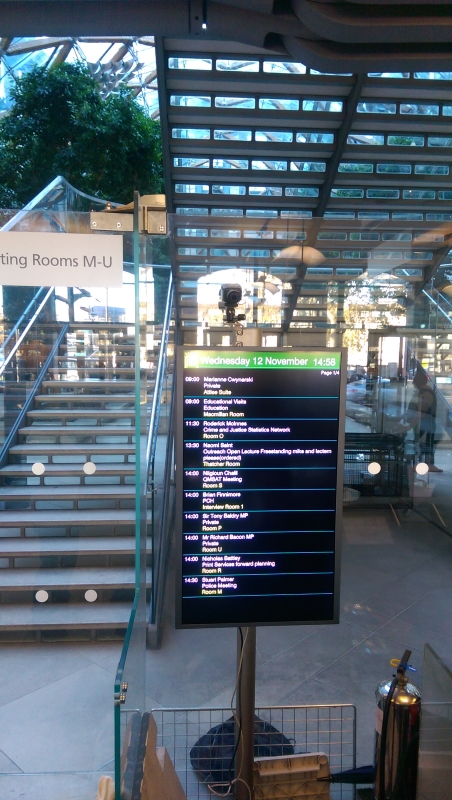More case studies
Parliament
10 September 2015

At the beginning of February 2012 we were asked if we could replace the existing fifteen screen digital signage system in Parliament with an updated solution that would utilise the existing fixings as far as possible to minimise the heritage impact. We had originally installed the system in 2004.
The original system had passed its anticipated end-of-life by some margin. Development of the software had ended and spare parts for the hardware were no longer available. There was a risk that a critical component failure would permanently stop a screen or the whole system.
We had six weeks to design, manufacture and install it before the financial year end to enable the customer to be as economic as possible with available resources.
The installation took place during the third week of March over a period of four days and resulted in a total success. By the end of that period all fifteen screens had been installed and were working perfectly. Two members of the PICT team had been assigned to escort us during the process and provided us with invaluable knowledge and considerable hands-on assistance.
Our Solution
Hardware
The new system replaces the screens situated in the Lords, Commons and some public areas of the Palace of Westminster with new 40” LED backlit Samsung 1080p screens mounted in portrait within custom frames. They are bigger, brighter and have a clearer image than the previous screens. Their response is very much faster and they are easier to manage via the iMERGE user interface.
All parts are standard, easily obtainable PC components with the exception of the screen housings. The PC motherboard and power supply are contained within the casing. In order to make the system resilient, each screen controller has been configured as a server. Screens remain independent and any single failure will not affect the other screens. The system uses SSDs (Solid State Drive) instead of hard disks which add greater reliability.
Software
The iMERGE software within each controller fetches XML data from a web server and generates the appropriate image for the screen. Each screen polls the XML every ten seconds.
Remote monitoring of individual screens is via their individual web interface. We have created a web page that generates a screen capture from each of the units on a single page. This allows PICT to monitor screen output and avoids any unnecessary ‘tours’ of the estate to confirm all screens work correctly.
No impact on the buildings fabric
We knew English Heritage and other interested parties had a voice with regard to the introduction of technology within the building so our work was undertaken with great sensitivity.
The new screens have been mounted on existing brackets and poles etc to keep the disruption to day-to-day business to an absolute minimum. Some minor modifications were necessary but they do not alter the fabric nor are they visible to members of either House, their officers or the public.
Aesthetics have been maintained
The same look and feel was maintained through the use of the same colours and fonts. The screen housings are in the same colour, namely dark brown, black or silver, whichever is appropriate to the screens location.
Summary
The new system provides all the functionality available on modern digital signage system with the generation of dynamic and eye-catching screen displays which are available and ready for future use. The existing data feeds remain in place but contingency has been made to include newer versions of this as and when the business is ready to implement the changes.
The iMERGE software is in use at the Guildhall (Corporation of London), as well as by many public and private organisations.
back to case studies